One Perfect Day in Arches National Park
Do you only have one day in Arches National Park and looking for all the best things to do there? I’ve put together this one day Arches itinerary with all the highlights of Arches included.
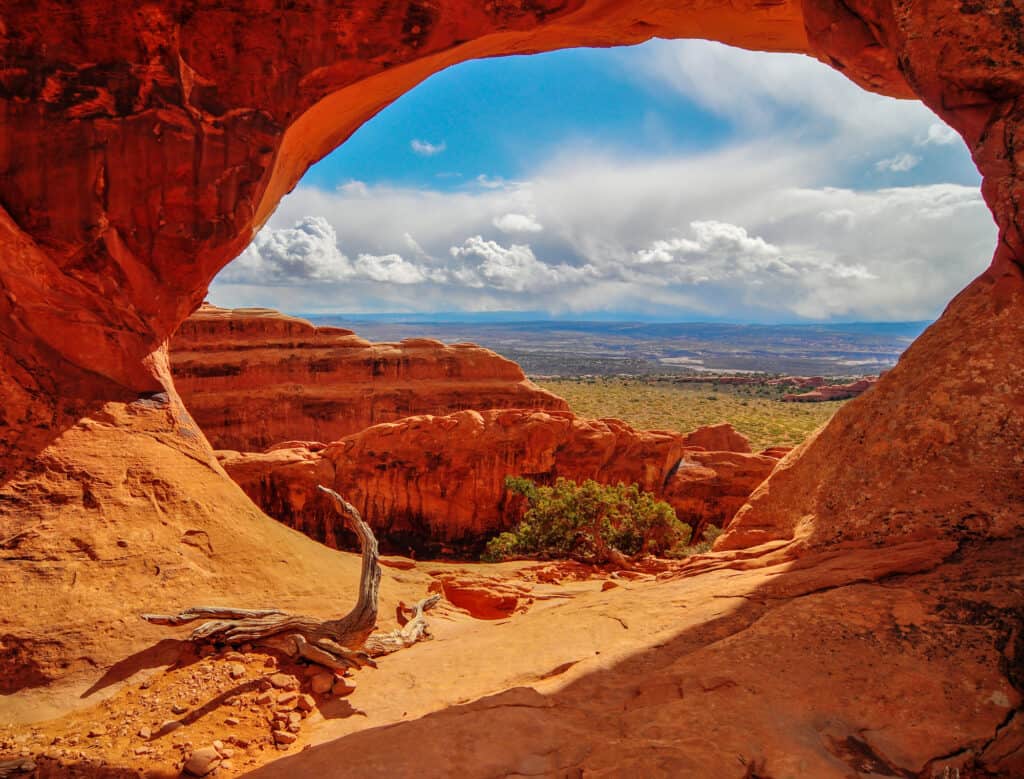
Arches is a small National Park just outside of Moab, Utah which also makes it one of the most popular parks to visit. My suggestion is to arrive early as Arches is often full by 9am!
Arches is part of Utah’s Mighty Five National Parks. While I think Zion is the most popular, Arches is second. Your main attractions in the park are of course – arches! I have included the best ones on the list along with some other hidden gems.
So let’s explore Arches National Park in one day – when you are short on time!
Thank you for supporting this website written by an American. This post may contain affiliate links. This means I earn a small commission on these links at no extra cost to you.
National Park Entrance Fees
To enter the National Parks, you’ll need to pay an entrance fee or have a National Parks Pass also known as American the Beautiful Pass.
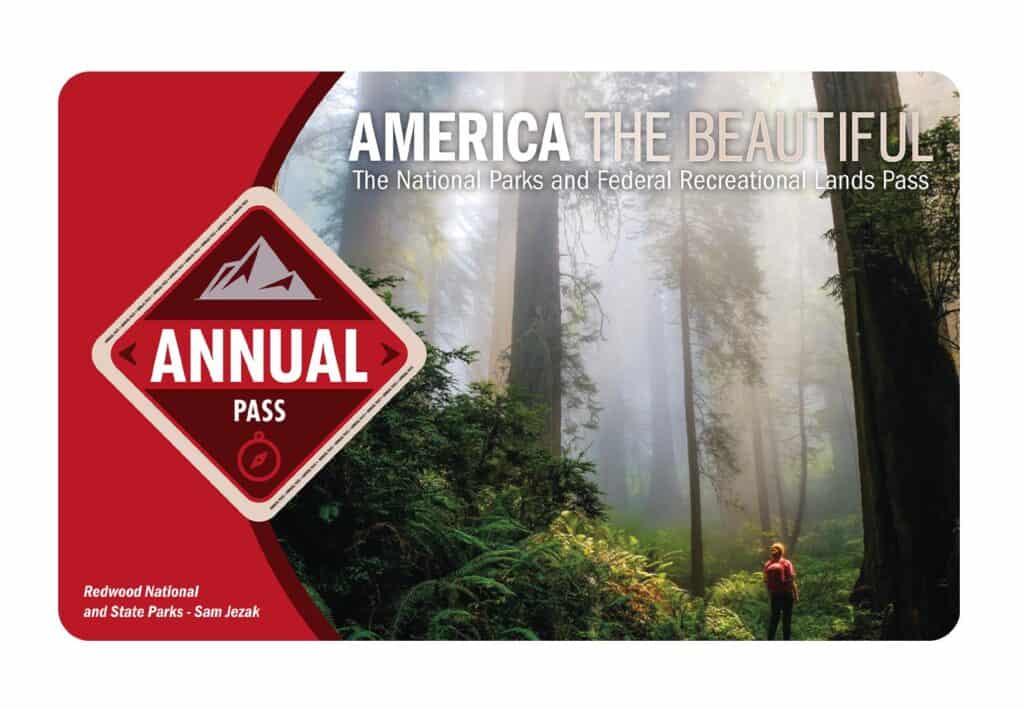
It costs $80 for a yearly America the Beautiful Pass. This gives you access to all national parks and federal areas that charge fees. The America the Beautiful Pass is well worth it!
I purchased my first one in 2016 and it’s such a money-saver! Plus 10% of sale proceeds go to the National Park Foundation.
Tips for Visiting Grand Teton National Park
Grand Canyon National Park is perfect for outdoor enthusiasts. There is something for everyone on this list and for different fitness levels. Also, note that it is dry and hot (in the summer), and make sure you know what you are getting into before you start. Here are a few tips for visiting the Grand Canyon:
- Bring a reusable water bottle and lots of water! Remember you are in the sun and you will need to drink lots of water. I love my LifeStraw Filtered Water Bottle. I can refill this bottle anywhere and it comes with a carabiner to connect it to my daypack.
- Check the Weather – days over 100 degrees are very common. Make sure to check.
- Hiking boots or sandals that will protect your feet! I love good shoes. I need all the support and help I can get. I actually love these sandals for hiking and also love these hiking boots.
- Bring hiking poles for balance and to protect your knees. I know many experienced hikers (and even amateur ones) think that hiking poles are for old people who lose their balance. Actually, hiking poles can help when going down steep inclines or when scrambling over rocks. They are great to hike with even for the most experienced hiker.
- Wear a sunhat. I feel like this whole post is about how high you are in the mountains and how much closer you are to the sun but it is so true. At elevation, you are closer to the sun and more likely to burn. Wear sun protection such as a sun hat and sunscreen.
- Be aware of the wildlife. This is the Southwest and you will need to watch out for snakes and other wildlife such as moose or a bear. Please stay away from wildlife and do not feed them. I recommend carrying bear spray as well.
- Start Early – If you want to avoid the traffic and the heat you will need to start your hike early. That way it will be nice and cool and the smog will not affect you either.
- Leave no trace. If you are new to the concept of Leave No Trace it is all about preserving the environment to ensure it is in the same or better condition when you leave it. This means that you should stick to the trails and carry out everything that you carried in. This is a great explanation of the Leave No Trace principles!
- Water shoes are great for water hikes– If you don’t have a pair, I highly suggest it as they are affordable. I have an article on the pros and cons of several pairs of water shoes.
- Bring Bug Spray and a snack: Be sure to bring everything you need including a snack like a protein bar plus BUG SPRAY.
Where to stay near Grand Canyon National Park
The Grand Canyon makes for a great weekend escape. Fresh air, beautiful scenery and being in nature does a world of good for the soul. I recommend staying as close to the park as possible and even treating yourself with a cabin with a spa pool to relax at night.
- There are lots of fantastic Airbnbs near the Grand Canyon. I have made a list of the best airbnbs around the park wherever you decide to stay. You can also check out my post on Where to Stay near the Grand Canyon to find the perfect hotel for any budget.
If you are taking a road trip remember to reserve a car in advance using Discover Cars .
National Park Entrance Fees
To enter the National Parks, you’ll need to pay an entrance fee or have a National Parks Pass also known as American the Beautiful Pass.

It costs $80 for a yearly America the Beautiful Pass. This gives you access to all national parks and federal areas that charge fees. The America the Beautiful Pass is well worth it!
I purchased my first one in 2016 and it’s such a money-saver! Plus 10% of sale proceeds go to the National Park Foundation.
Tips for Visiting Grand Teton National Park
Grand Canyon National Park is perfect for outdoor enthusiasts. There is something for everyone on this list and for different fitness levels. Also, note that it is dry and hot (in the summer), and make sure you know what you are getting into before you start. Here are a few tips for visiting the Grand Canyon:
- Bring a reusable water bottle and lots of water! Remember you are in the sun and you will need to drink lots of water. I love my LifeStraw Filtered Water Bottle. I can refill this bottle anywhere and it comes with a carabiner to connect it to my daypack.
- Check the Weather – days over 100 degrees are very common. Make sure to check.
- Hiking boots or sandals that will protect your feet! I love good shoes. I need all the support and help I can get. I actually love these sandals for hiking and also love these hiking boots.
- Bring hiking poles for balance and to protect your knees. I know many experienced hikers (and even amateur ones) think that hiking poles are for old people who lose their balance. Actually, hiking poles can help when going down steep inclines or when scrambling over rocks. They are great to hike with even for the most experienced hiker.
- Wear a sunhat. I feel like this whole post is about how high you are in the mountains and how much closer you are to the sun but it is so true. At elevation, you are closer to the sun and more likely to burn. Wear sun protection such as a sun hat and sunscreen.
- Be aware of the wildlife. This is the Southwest and you will need to watch out for snakes and other wildlife such as moose or a bear. Please stay away from wildlife and do not feed them. I recommend carrying bear spray as well.
- Start Early – If you want to avoid the traffic and the heat you will need to start your hike early. That way it will be nice and cool and the smog will not affect you either.
- Leave no trace. If you are new to the concept of Leave No Trace it is all about preserving the environment to ensure it is in the same or better condition when you leave it. This means that you should stick to the trails and carry out everything that you carried in. This is a great explanation of the Leave No Trace principles!
- Water shoes are great for water hikes– If you don’t have a pair, I highly suggest it as they are affordable. I have an article on the pros and cons of several pairs of water shoes.
- Bring Bug Spray and a snack: Be sure to bring everything you need including a snack like a protein bar plus BUG SPRAY.
Where to stay near Grand Canyon National Park
The Grand Canyon makes for a great weekend escape. Fresh air, beautiful scenery and being in nature does a world of good for the soul. I recommend staying as close to the park as possible and even treating yourself with a cabin with a spa pool to relax at night.
- There are lots of fantastic Airbnbs near the Grand Canyon. I have made a list of the best airbnbs around the park wherever you decide to stay. You can also check out my post on Where to Stay near the Grand Canyon to find the perfect hotel for any budget.
If you are taking a road trip remember to reserve a car in advance using Discover Cars .
One Day in Arches National Park, Utah
Sunrise Delicate Arch Hike
Among the more than 2,000 stone arches in Arches National Park, Delicate Arch stands out as a symbol of Utah and one of the most well-known geological phenomena on the planet. The arch, which has a 46-foot-high and 32-foot-wide entrance, is the park’s largest free-standing arch, and it appears to defy gravity in its height and shape, as the name implies.
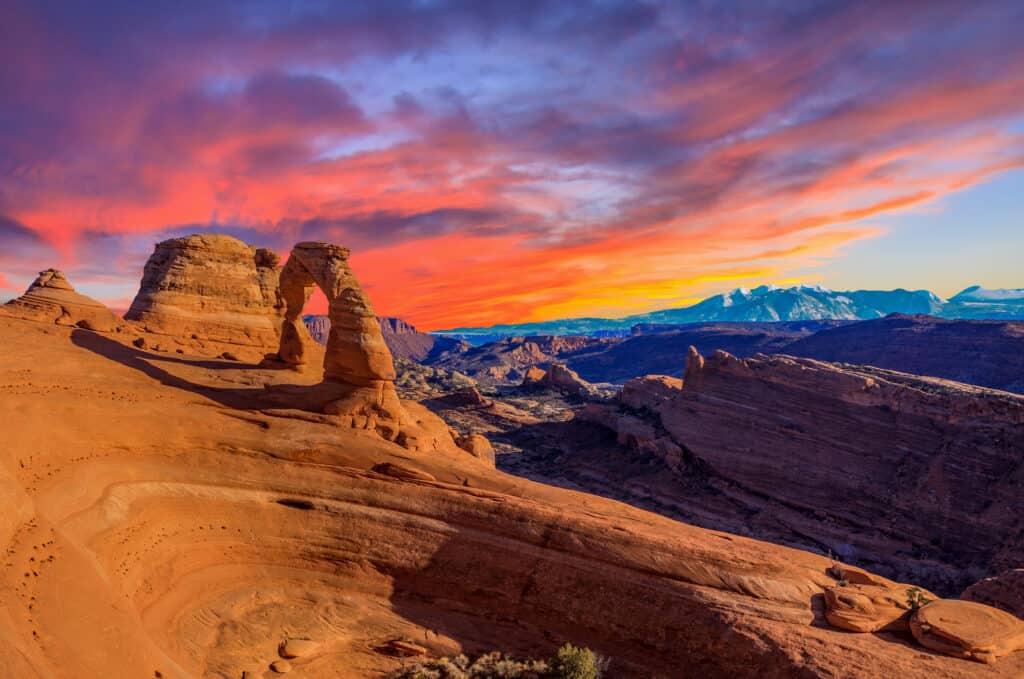
This hike is not for the faint of heart, as it includes a major ascent up a steep slick rock slope. Since there is no shade and it becomes rather hot in the summer, anyone traveling this trail should be prepared.
There are two alternative viewing possibilities for those who aren’t up for the hike:
- The Lower Delicate Arch Viewpoint, located close down the road, takes only a 100-yard walk over flat ground to get a great view of the arch from a mile away.
- The Upper Viewpoint, significantly less obscured but requires a half-mile trek with some stairs.
The Delicate Arch Trail is the only opportunity for visitors to get a good look at the formation up close because the opening of the arch cannot be viewed from the road.
From the Arches National Park entrance, the Delicate Arch hiking trail is easily accessible. After driving about 12 miles away from the main route, seek the Delicate Arch signs.
The park’s temperature ranges from 65 to 85 degrees during the day in the spring and fall, with evenings being up to 30 degrees lower. Daytime temperatures in the summer often exceed 100 degrees, making morning and nighttime hikes preferred. Make sure to bring along sunscreen and extra water for any summer hike.
The trail is available all year, and you may take advantage of the close serenity in the winter. However, you should be warned that the track, which can become slippery, may require the use of poles or shoe spikes.
Morning: Visit Balanced Rock and Garden of Eden
Balanced Rock, one of the park’s most recognizable attractions, stands at a towering 128 feet (39 meters). While this formation may appear to be an epic balancing act, it’s not balanced at all. The Entrada Sandstone boulder is firmly linked to its disintegrating Dewey Bridge mudstone pedestal. These two rock strata layers’ exposure is optimal for the creation of arches and balanced structures.
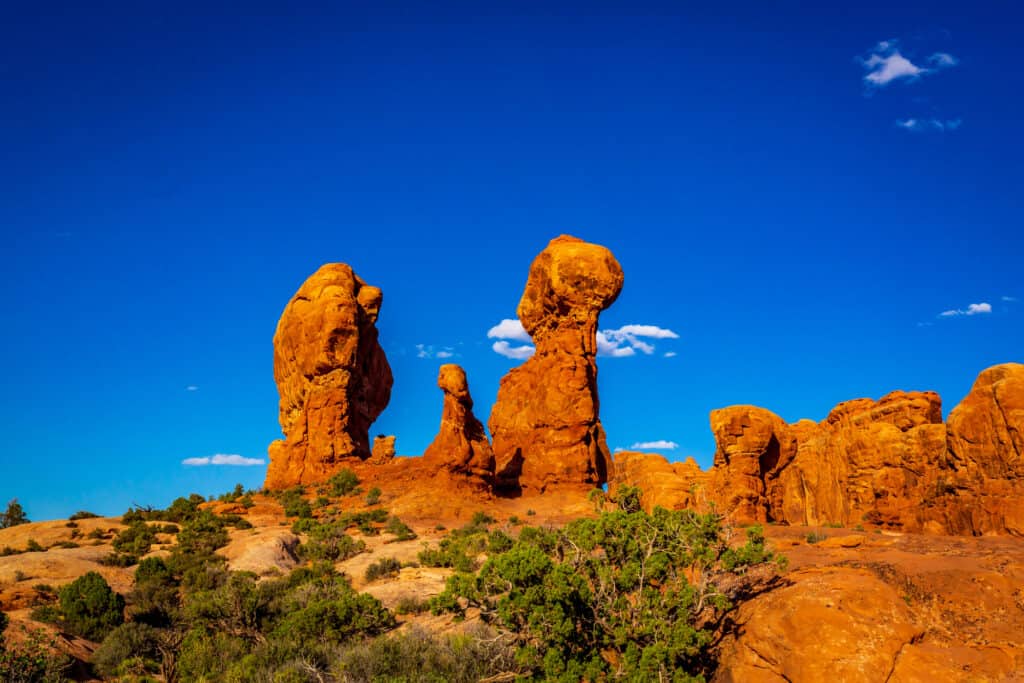
Although Balanced Rock appears to defy gravity, this is not always the case. As the erosional process continues to change the terrain, the 3,600 ton (nearly 4 million kg) boulder will eventually come crashing down. Balanced Rock’s smaller twin “Chip-Off-the-Old-Block” crashed in the winter of 1975-76, indicating that there is no better time than now to observe this awe-inspiring giant.
Balanced Rock, unlike many of the other designated features in the park, is visible from the park road. The Arches Visitor Center is 9.2 miles (14.8 kilometers) away. Despite the limited parking, many tourists stop to complete the short hike around the base of the rock for unique and up-close views.
A picnic place is located across the road from Balanced Rock on a dirt road to the west. Multiple picnic tables, a covered canopy, a vault toilet, and breathtaking views of Salt Valley and Balanced Rock can be found in the picnic area.
Balanced Rock becomes a deep red-orange color after sunset, making it a perfect site to cap a fun-filled day in the park. This is also a great spot for night photography and stargazing. It’s just far enough away from Moab, Utah’s city lights to create whimsical granite spires in the foreground.
The Garden of Eden is a place full of oddly sculpted rock formations and spires that look a lot like Balanced Rock. Climbers will occasionally attempt the spires on their own, although most visitors come here for a short stroll. This is a great site to go for a walk and get a sense of the size of the surrounding rocks.
The knobby hoodoos and sandstone rock formations are worth the quick stop. There is a pull-out just before the Garden of Eden for a panoramic view of the Windows and Turret Arches set against the backdrop of the La Sal Mountains.
Turn left onto Garden of Eden Viewpoint Road from The Windows Road. This can be done before or after seeing the Double Arch, Windows, and Turret arches.
Visit the Windows Section and Double Arch
The Windows Section is considered by some to be the beating heart of Arches National Park. The area has a high concentration of arches and is one of the park’s most picturesque spots. In just over two square miles, you’ll see awe-inspiring panoramas like North Window, Turret Arch, and Double Arch.
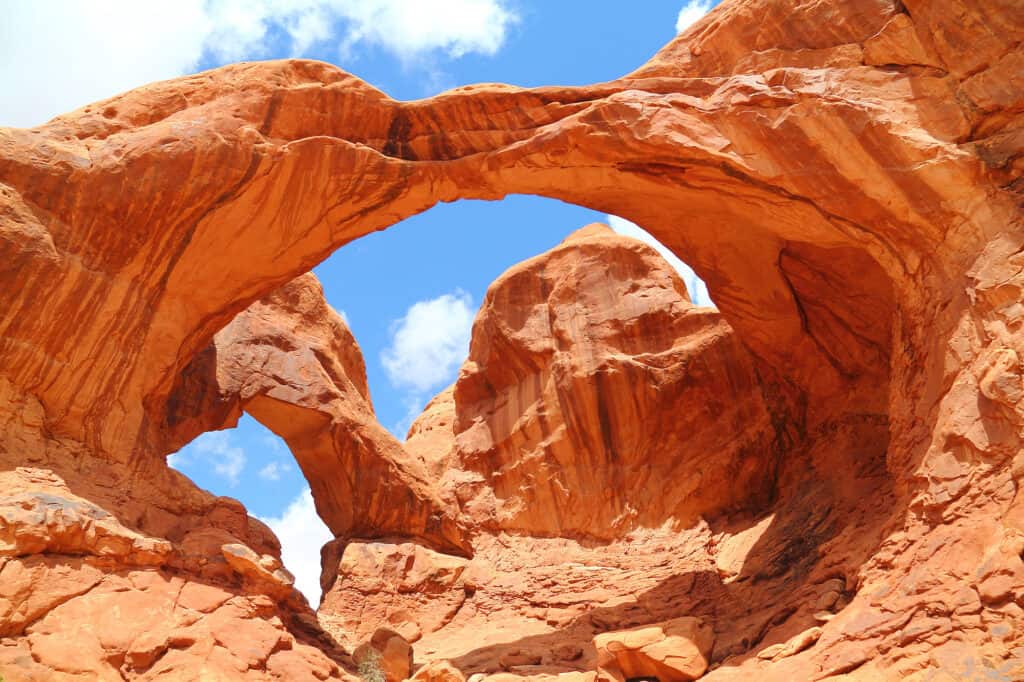
A one-way loop with two parking lots is located at the end of Windows Road. The North Window is directly in front of one lot, while Double Arch is directly across the street from the other. This hike implies that you park at the North Window. A small (0.15-mile) trail connects the two lots and cuts through the loop. Alternatively, you can walk between the two sites on the circular road’s sidewalk (.17 miles).
Follow a paved trail up on easy hills from the Windows parking area to the North Window. To the northwest, turn around for a good view of the Double Arch formation. The back of the fin provides a unique view of the North and South Windows, as well as adjacent rock formations. Two canyons, cut by the Colorado River and Salt Creek, make their way through the fractured topography to the south and east. To the southeast, the La Sal Mountains dominate the scene, while beyond the canyons to the east, sandstone towers and cliffs rise.
The rudimentary trail returns to the west after a little more than a half-mile as it climbs around the north end of the fin. Views of Double Arch and the Parade of Elephants, a nearby rock structure, are available from here.
The trail to Double Arch is almost right across the road from the Windows parking area. The arch can be seen from the parking lot, but it’s even more amazing up close, where you can get a sense of its scale and see the sky streaming through the arches above.
Take the trail that cuts through the loop at the west end of the Windows parking lot to the Double Arch Parking area. Alternatively, take the sidewalk along the north/northwest side of the loop road to the start of the Double Arch route.
The ‘hike’ to Double Arch is only around half a mile long and is mostly flat. This is one of the few spots in the park where you can find some shade. Not only that, but this location offers a variety of stunning views. Climbing around on the rock will give you different perspectives on the two arches.
The trail to Double Arch is short and accessible to all, making it ideal for families. The trail becomes a bit of a scramble at the base of the arch, and you might choose to wander up the boulders beneath the arches.
The Windows Section and Double Arch are adjacent to one another and share a parking lot. Eating your lunch here in the shade or moving on to Devil’s Garden and locating a picnic table are the activities you can do.
Lunch: Picnic near Devil’s Garden
Picnic tables can be found throughout the park, but the one at Devil’s Garden is the largest because it is located next to the campground.
A four-site picnic facility with pit toilets, tables, fire pits, and elevated grills is available. No water is available. Also, bring your own firewood or charcoal, since firewood collecting is not allowed at the site. In Devils Garden, dogs must be kept on a leash at all times.
Having your picnic lunch here at one of the many picnic tables is recommended.
And, as a reminder, there are no restaurants or shops in Arches, so you’ll have to carry anything from Moab or order something from one of the restaurants.
Afternoon Devil’s Garden and Landscape Arch
The Devils Garden Trail in Arches National Park is one of the best hikes in Moab, Utah because of the trail’s seven incredible named arches, spectacular views of arches and rocky fins, easy access to the first three arches, and somewhat strenuous hiking required to see the arches at the end.
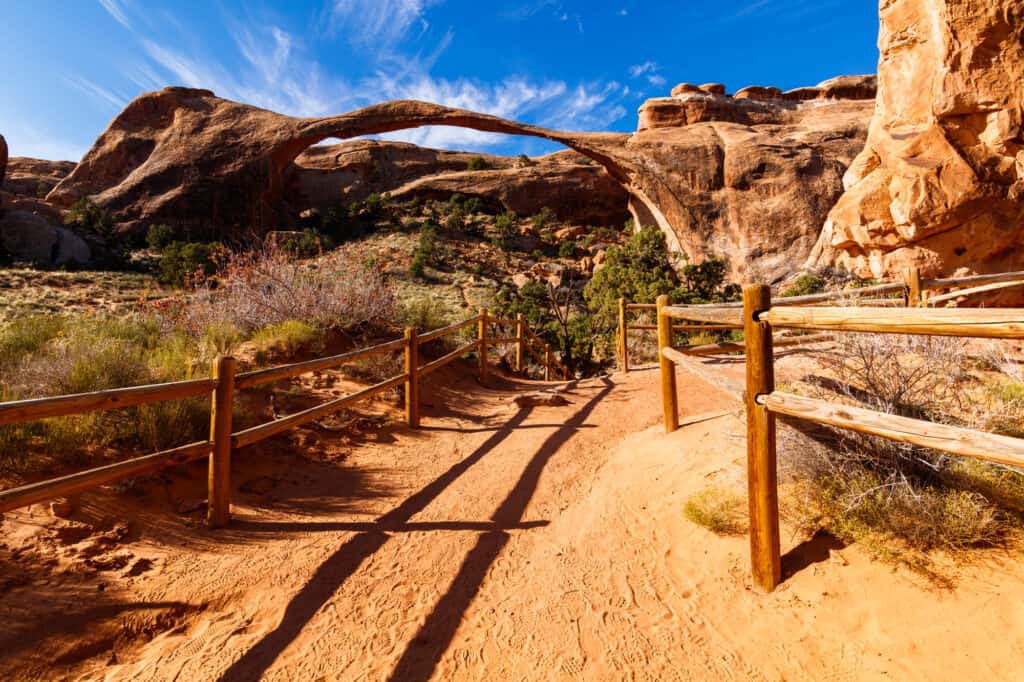
The trail allows you to get up close and personal with seven named arches, see many more arches from afar, and marvel at plains, the La Sal Mountain Range, and many other sandstone-rock structures that litter this path, which quickly progresses from easy to difficult.
Devils Garden is home to Landscape Arch, considered by the Natural Arch and Bridge Society (NABS) to be the longest natural arch in the world. It is a magnificent arch that spans an incredible 290 feet, narrowly edging out Kolob Arch in Zion for first place. Visiting just Landscape Arch is about a 1.5-mile roundtrip hike on a very wide and well-maintained trail.
During your adventures, you’ll come across miniature domes, tiny narrows carved by rivulets of infrequent runoff, and tiny pour-offs. Following the upper, left-hand trail from the picnic site, you’ll come across a small arch spanning a gully.
The lower trail skirts the base of Devils Garden’s erosion formations, passing Mano Arch and a slew of red-and-beige-toned sandstone hoodoos and mushroom rocks that rise from the pinyon- and juniper-studded bench. The area is also crisscrossed by hiker-made trails.
Landscape Arch
The Landscape Arch observation area is located below and to the right of the arch. You are not permitted to cross through the obstacles in place to get closer to the arch since it may collapse at any time.
his is the most popular and easiest to access arch on this trail. Landscape Arch is the first arch you will see on Devil’s Garden route if you hike the whole loop in an anticlockwise direction.
Landscape Arch is the park’s longest arch, stretching 306 feet (96 meters), but it’s just around 11 feet thick at its weakest point. Landscape Arch is still standing, which is pretty astounding.
Landscape Arch has experienced problems with erosion in recent years. Since 1991, sandstone blocks measuring 30, 47, and 70 feet have fallen from the arch’s narrowest part. Hikers used to be able to go beneath the arch, but it was blocked for safety reasons.

The majority of visitors come to see Landscape Arch. You may get there by hiking the Primitive Loop hike. With a length of 7.8 miles, this is the most popular hiking trail in Devil’s Garden, but you can make it shorter or longer depending on your preferences. Seven natural arches can be found if you walk the entire loop.
• Tunnel Arch – 0.4miles
• Pine Tree Arch – 0.5 miles
• Landscape Arch – 1.6 miles
• Partition Arch – 2 miles
• Navajo Arch – 2 miles
• Double O Arch – 2.3 miles
• Dark Angel – 2.5 miles
I recommend hiking to Landscape Arch and back if you don’t want to tackle the entire loop. It’s a 1.6-mile loop that takes you past one of the park’s most famous arches.
You can return to the trailhead from here if you only wanted to see Landscape Arch. Continue if you want a little more excitement – the trail now leaves the ground and climbs up one of those long, thin sandstone fins. On this really enjoyable portion of the trail, you’ll gain roughly 250 feet in a quarter-mile while also getting a unique perspective on the rest of the scenery.
Scenic Drive back to the entrance
You can spend a couple of hours or the greater part of a day driving around Arches National Park on the 36-mile (round trip) road. You can appreciate the magnificent beauty and majesty of Arches without having to leave your vehicle, with plenty of places to stop and take pictures and panoramic views for kilometers.
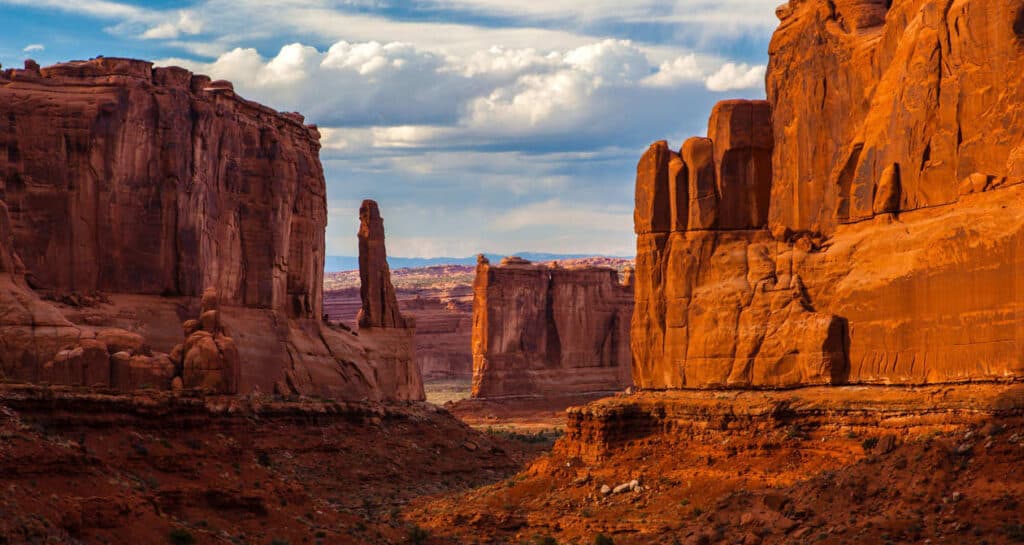
I strongly recommend driving the entire 36-mile Arches Scenic Drive. It’s best to stop at the numerous views along the picturesque drive and getting out to hike Arches National Park’s widely accessible trails to get the most out of your visit.
You may expect to spend 3 to 3.5 hours driving through Arches National Area with stops along the way if you plan on visiting the park. Hiking on the trails is also not included in this time limit. Please keep in mind that the amount of time you spend depends largely on how many stops you make and how long you stay at each one. Without making any stops at all, driving from the bottom to the top and back will take approximately 2 hours.
As a result, there are multiple stops to be made on the route out of the park. A variety of viewpoints with panoramic views of the park’s rock formations can be found along the drive. Along with the arches, you’ll witness massive sandstone fins and towering rock spires. You can’t go wrong with any of the overlooks, so take your time and enjoy the scenery.
The best stops along the scenic drive are:
- The Three Penguins
- The Three Gossips
- Balanced Rock
- The Windows
- The Fiery Furnace
- Park Avenue (Mentioned in the next stop)
Stop at Park Avenue to take in the view or take a short hike
The Park Avenue Trail is one of Arches National Park’s first significant attractions. It’s a one-mile trail that winds its way through a canyon at the base of some of the park’s most famous monoliths.
At Park Avenue, you can gaze down a grand boulevard of rock and let your imagination loose. Previous visitors named some of the rock features here “Queen Nefertiti,” “Queen Victoria,” and “Sausage Rock” (also known as “The Corndog”).
Park Avenue Trail is a moderate hike that leads past a soaring rock skyline of massive fins and curiously carved towers beyond the viewpoint. The trail descends steeply into the magnificent canyon for one mile (1.6 km) to Courthouse Towers Viewpoint. Instead of going down the road, retrace your steps along the trail for a roundtrip hike.
The Park Avenue Trail is a one-mile trail that winds through a canyon at the base of some of the park’s most famous monoliths. From Park Avenue Trail, the following viewpoint may be visible:
- The Three Gossips
- Courthouse Towers
- Queen Nefertiti and Queen Victoria Rock
- The Organ
- and the Tower of Babel
This two-mile round-trip trail can be hiked or you can simply pull over and enjoy the scenery. A breathtaking vista of the park is visible on your way.
Recent Posts
15 Tips for Visiting the Grand Canyon in September – 2023 Ultimate Guide
Visiting the Grand Canyon in September is a great time to visit. September is a busy time to visit but the crowds are starting to arrive especially toward the end of the month. I’ve included...
15 Tips for Visiting the Grand Canyon in August – 2023 Ultimate Guide
Visiting the Grand Canyon in August is a great time to visit. August is a busy time to visit but the crowds are starting to arrive especially toward the end of the month. I’ve included all...
